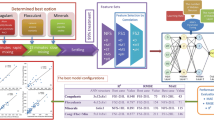Abstract
In this study, Grey model (GM) and artificial neural network (ANN) were employed to predict suspended solids (SSeff) and chemical oxygen demand (CODeff) in the effluent from a wastewater treatment plant in industrial park of Taiwan. When constructing model or predicting, the influent quality or online monitoring parameters were adopted as the input variables. ANN was also adopted for comparison. The results indicated that the minimum MAPEs of 16.13 and 9.85% for SSeff and CODeff could be achieved using GMs when online monitoring parameters were taken as the input variables. Although a good fitness could be achieved using ANN, they required a large quantity of data. Contrarily, GM only required a small amount of data (at least four data) and the prediction results were even better than those of ANN. Therefore, GM could be applied successfully in predicting effluent when the information was not sufficient. The results also indicated that these simple online monitoring parameters could be applied on prediction of effluent quality well.
Similar content being viewed by others
References
APHA, AWWA, & WEF (1995). Standard methods for the examination of water and wastewater (19st ed.). Washington DC: American Public Health Association/American Water Works Association/Water Environment Federation.
Chang, N. B., & Wang, S. F. (1995). A grey nonlinear programming approach for planning coastal wastewater treatment and disposal systems. Water Science and Technology, 32, 19–29.
Chang, N. B., Wen, C. G., Chen, Y. L., & Yong, Y. C. (1996a). A grey fuzzy multiobjective programming approach for the optimal planning of a reservoir watershed. Part A: Theoretical development. Water Research, 30, 2329–2334.
Chang, N. B., Wen, C. G., Chen, Y. L., & Yong, Y. C. (1996b). A grey fuzzy multiobjective programming approach for the optimal planning of a reservoir watershed. Part B: Application. Water Research, 30, 2335–2340.
Cote, M., Grandjean, B. P. A., Lessard, P., & Thibault, J. (1995). Dynamic modeling of activated sludge process: improving prediction using neural networks. Water Research, 29, 995–1004.
Deng, J. (1989). Introduction to grey system theory. The Journal of Grey System, 1, 1–24.
Gontarski, C. A., Rodrigues, P. R., Mori, M., & Prenem, L. F. (2000). Simulation of an industrial wastewater treatment plant using artificial neural networks. Computers and Chemical Engineering, 24, 1719–1723.
Jeong, H. S., Lee, S. H., & Shin, H. S. (2007). Feasibility of on-line measurement of sewage components using the UV absorbance and the neural network. Environmental Monitoring and Assessment (in press). DOI 10.1007/s10661-006-9555-4.
Pai, T. Y. (2007). Modeling nitrite and nitrate variations in A2O process under different return oxic mixed liquid using an extended model. Process Biochemistry, 42, 978–987.
Pai, T. Y. (2008). Grey and neural network prediction of effluent from the wastewater treatment plant of industrial park using influent quality. Environmental Engineering Science. (in press).
Pai, T. Y., Chiou, R. J., & Wen, H. H. (2008). Evaluating impact level of different factors in environmental impact assessment for incinerator plants using GM (1, N) model. Waste Management. (in press).
Pai, T. Y., Chuang, S. H., Tsai, Y. P., & Ouyang, C. F. (2004a). Modelling a combined A2O and RBC process under DO variation by using an activated sludge – Biofilm hybrid model. Journal of Environmental Engineering, ASCE, 130, 1433–1441.
Pai, T. Y., Tsai, Y. P., Chou, Y. J., Chang, H. Y., Leu, H. G., & Ouyang, C. F. (2004b). Microbial kinetic analysis of three different types of EBNR process. Chemosphere, 55, 109–118.
Pai, T. Y., Hanaki, K., Ho, H. H., & Hsieh, C. M. (2007a). Using grey system theory to evaluate transportation on air quality trends in Japan. Transportation Research Part D: Transport and Environment, 12, 158–166.
Pai, T. Y., Tsai, Y. P., Lo, H. M., Tsai, C. H., & Lin, C. Y. (2007b). Grey and neural network prediction of suspended solids and chemical oxygen demand in hospital wastewater treatment plant effluent. Computers and Chemical Engineering, 31, 1272–1281.
Zhang, Q., & Stanley, S. J. (1999). Real-time water treatment process control with artificial neural networks. Journal of Environment Engineering ASCE, 125, 153–160.
Author information
Authors and Affiliations
Corresponding author
Rights and permissions
About this article
Cite this article
Pai, T.Y., Chuang, S.H., Wan, T.J. et al. Comparisons of grey and neural network prediction of industrial park wastewater effluent using influent quality and online monitoring parameters. Environ Monit Assess 146, 51–66 (2008). https://doi.org/10.1007/s10661-007-0059-7
Received:
Accepted:
Published:
Issue Date:
DOI: https://doi.org/10.1007/s10661-007-0059-7




